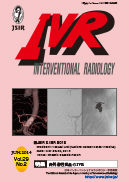Volume 29, Issue 2
Displaying 1-15 of 15 articles from this issue
- |<
- <
- 1
- >
- >|
State of the Art
Interventional Radiology for Nontraumatic Bleeding
-
2014Volume 29Issue 2 Pages 121-126
Published: 2014
Released on J-STAGE: April 22, 2015
Download PDF (918K) -
2014Volume 29Issue 2 Pages 127-133
Published: 2014
Released on J-STAGE: April 22, 2015
Download PDF (967K) -
2014Volume 29Issue 2 Pages 134-139
Published: 2014
Released on J-STAGE: April 22, 2015
Download PDF (1026K) -
2014Volume 29Issue 2 Pages 140-146
Published: 2014
Released on J-STAGE: April 22, 2015
Download PDF (1137K) -
2014Volume 29Issue 2 Pages 147-152
Published: 2014
Released on J-STAGE: April 22, 2015
Download PDF (1087K)
Case Reports
-
2014Volume 29Issue 2 Pages 153-156
Published: 2014
Released on J-STAGE: April 22, 2015
Download PDF (888K) -
2014Volume 29Issue 2 Pages 157-161
Published: 2014
Released on J-STAGE: April 22, 2015
Download PDF (932K)
-
2014Volume 29Issue 2 Pages 162-165
Published: 2014
Released on J-STAGE: April 22, 2015
Download PDF (837K) -
2014Volume 29Issue 2 Pages 166-172
Published: 2014
Released on J-STAGE: April 22, 2015
Download PDF (1292K) -
2014Volume 29Issue 2 Pages 173-180
Published: 2014
Released on J-STAGE: April 22, 2015
Download PDF (1576K) -
2014Volume 29Issue 2 Pages 181-185
Published: 2014
Released on J-STAGE: April 22, 2015
Download PDF (769K)
-
2014Volume 29Issue 2 Pages 186-187
Published: 2014
Released on J-STAGE: April 22, 2015
Download PDF (574K) -
2014Volume 29Issue 2 Pages 188-194
Published: 2014
Released on J-STAGE: April 22, 2015
Download PDF (1418K) -
2014Volume 29Issue 2 Pages 195-202
Published: 2014
Released on J-STAGE: April 22, 2015
Download PDF (1601K) -
2014Volume 29Issue 2 Pages 203-209
Published: 2014
Released on J-STAGE: April 22, 2015
Download PDF (1454K)
- |<
- <
- 1
- >
- >|
